Quck answer
Here is a list of 16 common lawn weeds and how to control them:
1. Dandelion: Remove by hand or use herbicides containing glyphosate or 2,4-D.
2. Crabgrass: Apply pre-emergent herbicides in early spring to prevent germination.
3. Clover: Hand-pull or use herbicides containing dicamba or triclopyr.
4. Plantain: Remove by hand or use herbicides containing 2,4-D or dicamba.
5. Thistle: Hand-pull before flowering or use herbicides containing glyphosate or triclopyr.
6. Chickweed: Hand-pull or use herbicides containing 2,4-D or dicamba.
7. Ground ivy: Apply herbicides containing dicamba or triclopyr in early spring or fall.
8. Purslane: Hand-pull or use herbicides containing glyphosate or 2,4-D.
9. Nutsedge: Hand-pull or use herbicides containing halosulfuron or sulfentrazone.
10. Creeping Charlie: Apply herbicides containing dicamba or triclopyr in early spring or fall.
11. Bermuda grass: Apply herbicides containing glyphosate or sethoxydim.
12. Wild violet: Hand-pull or use herbicides containing 2,4-D or dicamba.
13. Moss: Improve drainage and soil conditions, rake or scrape off the moss.
14. Henbit: Hand-pull or use herbicides containing 2,4-D or dicamba.
15. Prostrate spurge: Hand-pull or use herbicides containing 2,4-D or dicamba.
16. Annual bluegrass: Apply pre-emergent herbicides in early spring or fall to prevent germination.
Among the many disliked things in nature, lawn weeds are often at the top of the list. Similar to mosquitoes (which may hold the number one spot), weeds appear to exist solely to annoy us, despite the fact that mosquitoes provide food for numerous creatures. Weeds also serve as a food source for animals through the seeds they produce, but having weeds on your front lawn may be unwelcome, and you may want to remove them. Permanently, if you’re fortunate. With this noble objective in mind, here are 16 of the most prevalent weeds found in lawns and the most effective ways to combat them (choose your preferred method, or not).
1. Dandelion

Image Credit:
Eerik/iStock/GettyImages
Dandelions (Taraxacum officinale, USDA zones 3-10) are perennial wildflowers that are closely related to asters and daisies, but are widely considered as weeds. Dandelions thrive in areas where the turf is sparse, but they can seemingly survive anywhere, and most lawns have at least a few. Unsurprisingly, they spread through seeds (which often come from neighboring lawns). The challenge in controlling them lies in the fact that their root will regrow each year, while the seed heads can distribute hundreds of new seeds.
- Organic approach: Use a dandelion fork to dig them up and remove the long tap root; if the root remains, the plant will regrow. Pull them before they develop the fluffy, white seed heads, which can spread hundreds of seeds with even the slightest breeze.
- Inorganic approach: Apply an herbicide containing 2,4-D in early fall to kill the roots of the plants.
2. White Clover
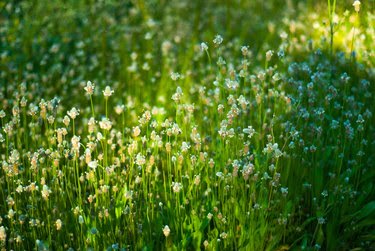
Image Credit:
By Eve Livesey/Moment/GettyImages
White clover (Trifolium spp., USDA zones 3-11, depending on the species) is a perennial weed that spreads through horizontal runners, or stolons, which develop roots. It can thrive in soil with low nitrogen levels (unfertilized) and is difficult to eliminate using organic methods. Currently, there is a movement to consider white clover as a desirable component of a turf lawn, but most people still wish to eradicate it.
- Organic approach: Hand-pulling is the most effective method. This works best in moist soil. Corn gluten meal can be applied as a pre-emergent herbicide in early spring to prevent the seeds from germinating, but this will prevent overseeding with grass in the fall.
- Inorganic approach: Use a broadleaf herbicide.
3. Crabgrass

Image Credit:
The Garden Counselor
Crabgrass (Digitaria spp.) is an annual weed grass that thrives in areas of the lawn with sparse and poorly nourished turf. It is challenging to eradicate because it produces numerous seeds in the fall, from which new plants emerge in the spring.
- Natural treatment: To maintain a full and healthy lawn and prevent crabgrass, overseed thin areas and keep the grass at a minimum height of 3 inches. When mowing in late summer, collect grass clippings to prevent the spread of crabgrass seeds. Gradually control crabgrass by using corn gluten meal to prevent the germination of its seeds.
- Inorganic treatment: If necessary, use a non-selective herbicide containing glyphosate, but be aware that this will also kill other plants. Broadleaf herbicides are often ineffective.
4. Bindweed

Image Credit:
Christian Handl/imageBROKER/GettyImages
Bindweed (Calystegia sepium, USDA zones 3-9) is a persistent perennial weed that grows quickly and spreads through its roots. These roots can survive in the soil for many years.
- Natural treatment: To eradicate bindweed, manually pull out young plants by cutting or removing the foliage at ground level to deprive the plant of photosynthesis. Repeat this process every one or two weeks until the plant dies, which may take several years.
- Inorganic treatment: Use a non-selective herbicide containing glyphosate.
5. Creeping Charlie

Image Credit:
Hans Lang/imageBROKER/GettyImages
Similar to bindweed, creeping Charlie or ground ivy (Glechoma hederacea, USDA zones 3-10) is a perennial weed that spreads through its stems. It has light purple flowers and requires diligent eradication methods.
- Natural treatment: Same as bindweed. Additionally, creeping Charlie can be killed with a solution of 5 teaspoons of Borax to 1 quart of water, but this should only be applied once per year.
- Inorganic treatment: Use a broadleaf herbicide specifically labeled as effective for creeping Charlie.
6. Moss

Image Credit:
Scotts
Moss thrives in damp, shady areas with acidic soil. Unlike other lawn weeds, moss reproduces through spores.
- Natural treatment: Remove moss by raking and using a shovel, then reseed the area with shade-tolerant grass. Alternatively, moss can be killed using a soap-based organic herbicide.
- Inorganic treatment: Use an herbicide specifically formulated for moss.
7. Broadleaf Plantain
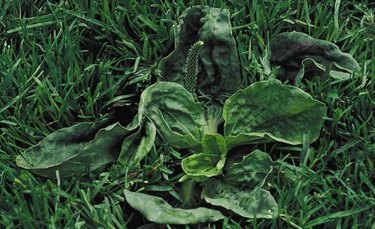
Image Credit:
Roundup
Broadleaf plantain (Plantago major, USDA zones 3-12) is a perennial weed that grows individually or in clusters and can tolerate various soil conditions. It has large, rubbery leaves similar to cabbage leaves and can reach a diameter of 12 inches.
- Natural treatment: Carefully hand-pull broadleaf plantain, using a weeding tool to remove the entire root. This method works best when the soil is wet.
- Inorganic treatment: Use a non-selective herbicide containing glyphosate or a broadleaf weedkiller.
8. Quackgrass

Image Credit:
Montana State University
Quackgrass (Elymus repens, USDA zones 3-9) is a rough-leaved grass that grows in clusters and develops tall seed shoots resembling wheat. It spreads through seeding and can regrow from roots left in the soil after removal. This perennial weed is difficult to eradicate.
- Organic treatment: Removing the roots by hand-weeding. Keeping the turf thick and healthy can also help reduce its growth.
- Inorganic treatment: Using a non-selective herbicide called glyphosate.
9. Dollarweed

Image Credit:
Scotts
Also known as pennywort, perennial dollarweed (Hydrocotyle umbellata, USDA zones 4-10) thrives in areas of lawns that are bare as well as in moist and shady spots. It has roundish leaves and white flowers.
- Organic treatment: Avoid overwatering the lawn and water less frequently but more deeply. Hand-weed if the spread of the weed is manageable.
- Inorganic treatment: Using a broadleaf herbicide.
10. Annual Bluegrass
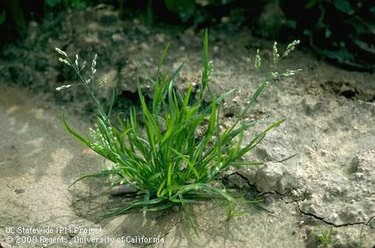
Image Credit:
UC IPM
Annual bluegrass (Poa annua) is a short annual weed with shallow roots. It prefers areas with short turfgrass that receive a lot of water and fertilizer, such as golf-course greens.
- Organic treatment: Mowing the lawn no shorter than 3 inches and watering less frequently but more deeply. Cutting back on fertilizer if heavily used.
- Inorganic treatment: It is best to use organic treatment, but pre-emergent herbicides can prevent the seeds from germinating.
11. Oxalis
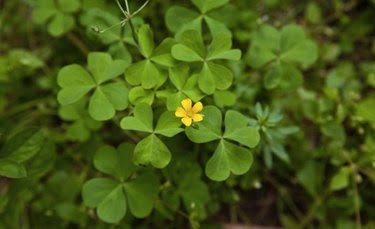
Image Credit:
Roundup
Also known as wood sorrel, perennial oxalis (Oxalis spp., USDA zones 3-11) has clover-like leaves and yellow flowers. It thrives in thin and dry lawn areas.
- Organic treatment: Overseeding and watering deeply and infrequently to fill in thin areas and crowd out the weed. It can be dug out when the soil is very moist.
- Inorganic treatment: Applying a locally-applied broadleaf herbicide or seasonally applying fertilizer with weed control.
12. Wild Violet
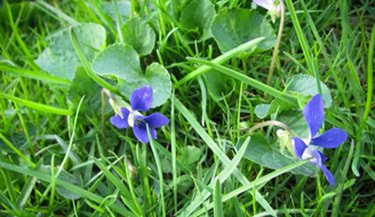
Image Credit:
Ortho
Considered by some to be attractive wildflowers, wild violet (Viola spp., USDA zones 3-7) is an aggressive perennial weed in shady areas of lawns. It is drought-tolerant once mature and has heart-shaped leaves and purple flowers.
- Organic treatment: Carefully and regularly hand-weeding to remove rhizomes and seeds.
- Inorganic treatment: Using a broadleaf herbicide slows down its growth but usually doesn’t kill it. A non-selective herbicide called glyphosate can kill it.
13. Canada Thistle
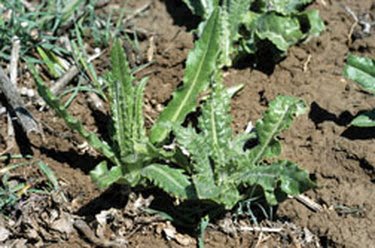
Image Credit:
Colorado State University Extension
With its thorny leaves and rapid growth, Canada thistle (Cirsium arvense, USDA zones 4-7) is an especially troublesome perennial weed in lawns and gardens. It spreads through seeding and root pieces and can grow up to 8 feet tall.
- Organic treatment: Carefully hand-weeding to remove the entire root.
- Inorganic treatment: Applying a selective herbicide to newly emerged leaves in spring is the best method.
14. Nutsedge
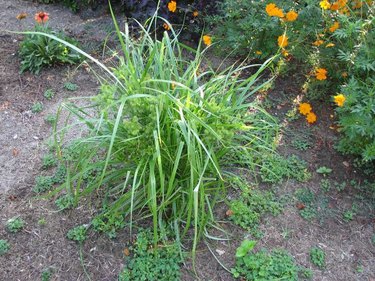
Image Credit:
Missouri Botanical Garden
Nutsedge (Cyperus spp., USDA zones 3-10) is a perennial grass-like sedge with triangle-shaped leaves. It thrives in clay soil and spreads through seeding and nutlike tubers underground.
- Organic treatment: Removing the nuts by hand and preventing the plants from producing seeds is the only effective way to control them.
- Inorganic treatment: Using herbicide specifically designed for nutsedge and applying it locally.
15. Chickweed

Image Credit:
Roundup
Chickweed (Stellaria and Cerastium spp.) consists of both perennial and annual species. It spreads easily with its stems and produces small white flowers. It typically grows in thin lawn areas and moist, shaded garden soil.
- Organic treatment: Removing the plants before they set seed by hand-weeding.
- Inorganic treatment: Using broadleaf herbicide, preferably applied locally.
16. Broad-Leaved Dock

Image Credit:
Ohio State University
Dock (Rumex spp., USDA zones 3-8, depending on species) can be identified by its long, oval leaves with red stalks. It is a perennial weed that develops deep taproots and can produce up to 60,000 seeds per plant.
- Organic treatment: Regularly spraying vinegar on the weed and scuffing its leaves to ensure penetration.
- Inorganic treatment: Using herbicide locally, which may require repeat application.
Tips for General Weed Control
The most effective way to control weeds in any lawn is to maintain a healthy and lush turf. It is important to prevent weeds rather than treat them. While chemical fertilizers and weed killers can be used to quickly restore a sick lawn, organic maintenance is the best long-term solution for the environment and the lawn’s health.
If your lawn needs significant help, using a fertilizer with broadleaf weed control, such as Scotts “Weed & Feed” products, can help manage weed growth. However, these products have limitations. They can only be applied twice a year and typically slow down weed growth rather than eliminate it. Therefore, it is recommended to follow up with hand-weeding or locally applied herbicide for broadleaf weeds at the recommended intervals. If your lawn has a lot of weeds and is not particularly strong, the weeds may thrive more than the turf during the beginning and end of the growing season. Using a fertilizer treatment that promotes turf growth while hindering weed growth can give the turf an advantage during these vulnerable times.
A non-chemical approach to weed control is to manually pull weeds by hand. Although this method requires labor and frequent attention, it is highly effective for many types of weeds and does not involve the use of chemicals. Hand-pulling works best when done regularly and when the weeds are removed from the root, which may require moist soil and digging tools. It is best to pull weeds before they flower or produce seeds. However, it is important to note that hand-pulling is less effective for weeds that spread underground, such as bindweed and nutsedge.


